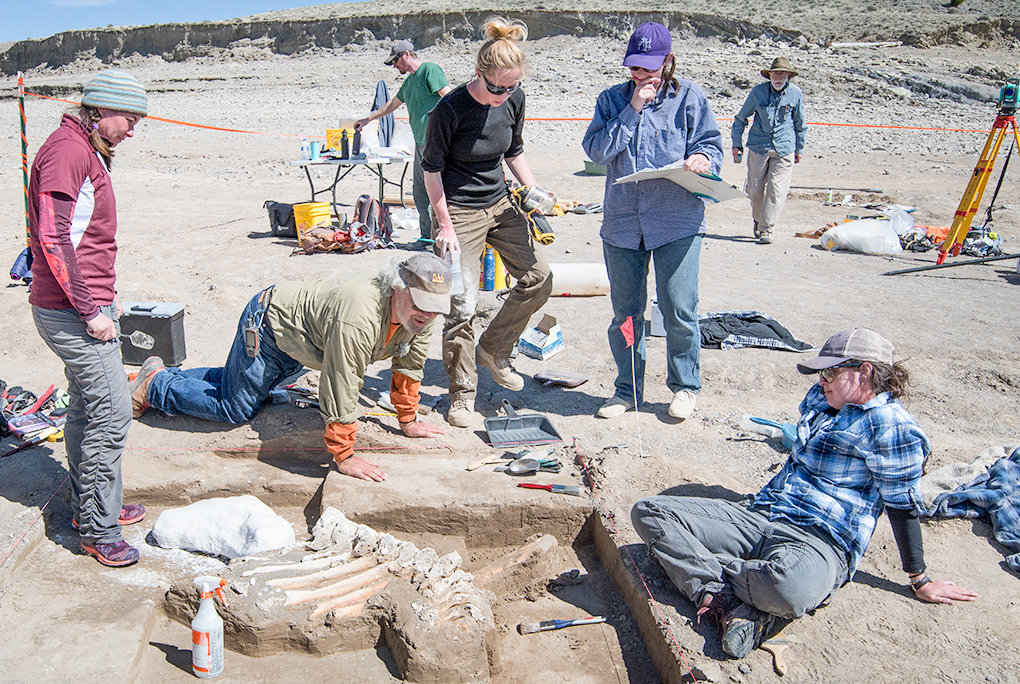Clear, 57° F
The age of a Columbian mammoth found at the Buffalo Bill Reservoir last year may never be known, a University of Wyoming archaeologist said last week.
Research on and salvaging of the so-called …
This item is available in full to subscribers.
The Powell Tribune has expanded its online content. To continue reading, you will need to either log in to your subscriber account, or purchase a subscription.
If you are a current print subscriber, you can set up a free web account by clicking here.
If you already have a web account, but need to reset it, you can do so by clicking here.
If you would like to purchase a subscription click here.
Please log in to continue |
|

The age of a Columbian mammoth found at the Buffalo Bill Reservoir last year may never be known, a University of Wyoming archaeologist said last week.
Research on and salvaging of the so-called Marquette mammoth continues at UW, but attempts to obtain a carbon date have failed. That’s due to a lack of organic material called collagen, Todd Surovell, a professor and head of the university’s archaeology department, told a packed house at the Buffalo Bill Center of the West on Thursday.
The remains — consisting of the vertebral column, ribs and other artifacts including mammoth teeth — were found on the bottom of the reservoir in April 2018. They surfaced while the reservoir was being drained in preparation for high water during last year’s spring ice melt and wound up being degraded by the exposure to air.
Most likely the mammoth is much older than 14,000 years — the dividing line scientists use between archaeology and paleontology. Surovell said no archaeological evidence was found at the site.
“If this animal died naturally, it’s much less interesting to me,” Surovell said. “Mammoths are cool, but I’m going to leave that to paleontologists.”
Mammoths made their way to the North American continent about 1.8 million years ago and were extirpated approximately 13,000 years ago, Surovell said. Proboscideans, a group of mammals that includes elephants and extinct mammoths and mastodons, once roamed most of the earth.
He theorizes people hunted the species until their populations crashed. “Humans show up and very shortly animals begin to go extinct.”
The last woolly mammoth is believed to have died about 4,000 years ago in an isolated section of Siberia, but Columbian mammoths — those that once walked in our neck of the woods — disappeared in Wyoming thousands of years earlier.
Had the Marquette mammoth died at the hands of Paleoindians, it would have been a rare archeological site — one of 16 in North America. But as a paleontological discovery, it’s not that rare.
“There’s really nothing unusual about finding fossilized elephant bones in Wyoming. You can pretty much find them everywhere,” Surovell said.
While it’s disappointing news that the Marquette mammoth is much older than hoped, Surovell shared good news about an earlier discovery.
Research continues on Douglas area mammoths
In 1938, a mammoth was found and excavated near Douglas. Surovell had seen the remains on display at the Douglas Pioneer Museum in 2014 and was curious as to how it died. But first, he had to figure out where the remains were found. “It took four years to figure out where these bones came from,” he said.
Eventually he was led to the excavation site on Bedtick Creek with the help of Pat Neill, who was at the dig site as a 12 year-old boy. Neill had since moved to the West Coast and only learned of the search for information when checking on news back home on the Douglas Budget website.
“If you are interested [in available evidence], let me know and I will dig into my old photo albums,” Neill wrote in an email to Surovell.
Out of dozens of photos he sent, two gave clues that eventually led to the dig site.
The bones have piqued Surovell’s interest because of the possibility humans killed the mammoth. There are only two known mammoth sites in Wyoming where scientists concluded that humans had a hand in the death of the animal: the Colby and La Prele sites.
The La Prele site, also near Douglas, has been the main focus of Surovell’s work since the site reopened in 2014. (A dispute with the landowner forced scientists to wait for 24 years to look for more archaeological clues.) In the past five years, new discoveries adjacent to the original dig — called the Chopper Block — has produced hundreds of flakes, bone fragments and at least eight stone tools. The site has also produced extremely rare finds, including bone needle fragments and a mysterious ocher stain.
Surovell hopes to find the same kind of evidence on Bedtick Creek, but that will take time. The discovery, dug up mostly by amateurs and left in the museum in a wood crate, is known as the Bishop mammoth.
The Marquette mammoth is still being processed at UW, but it is unlikely further recovery efforts at the reservoir will happen in the future.
If you’re interested in learning more about archaeology, the Wyoming Archaeology Fair will be held on Sept. 7 at the Wyoming Territorial Prison State Historic Site in Laramie.